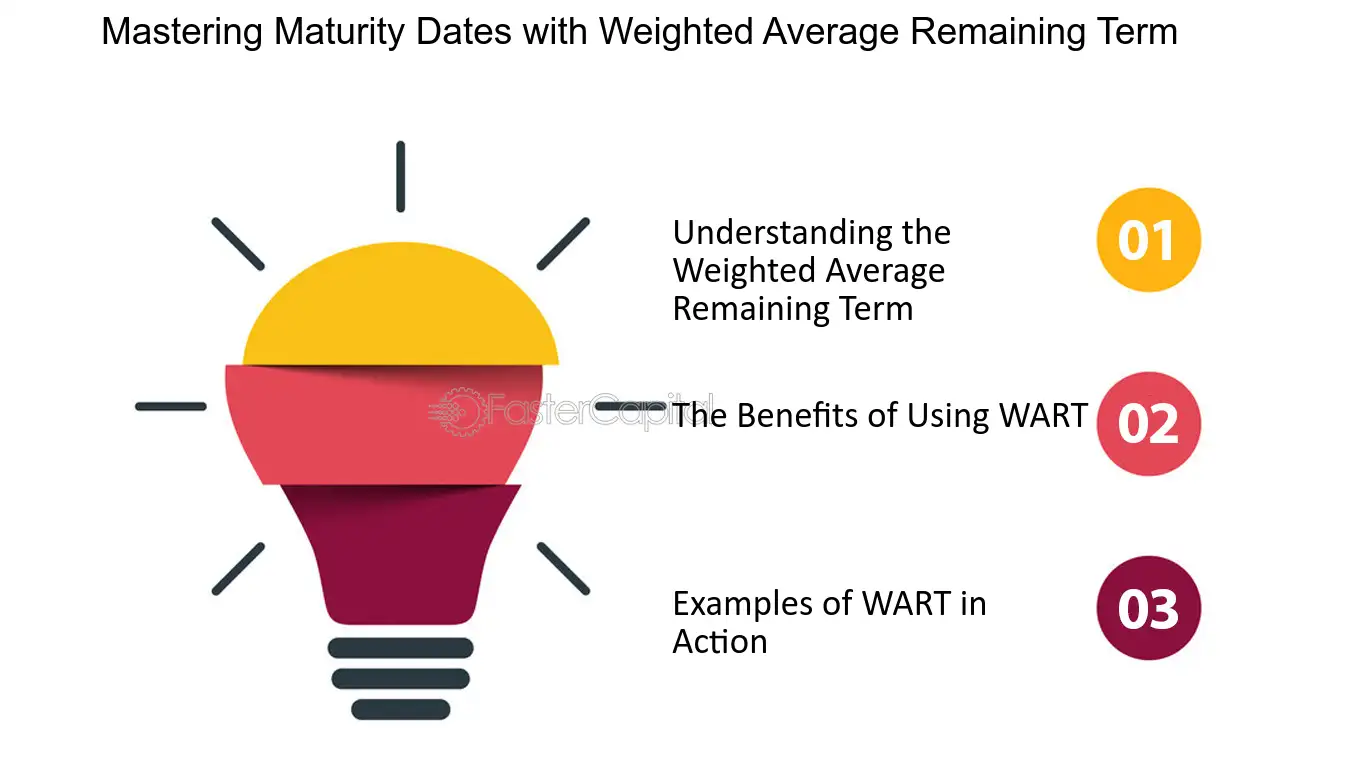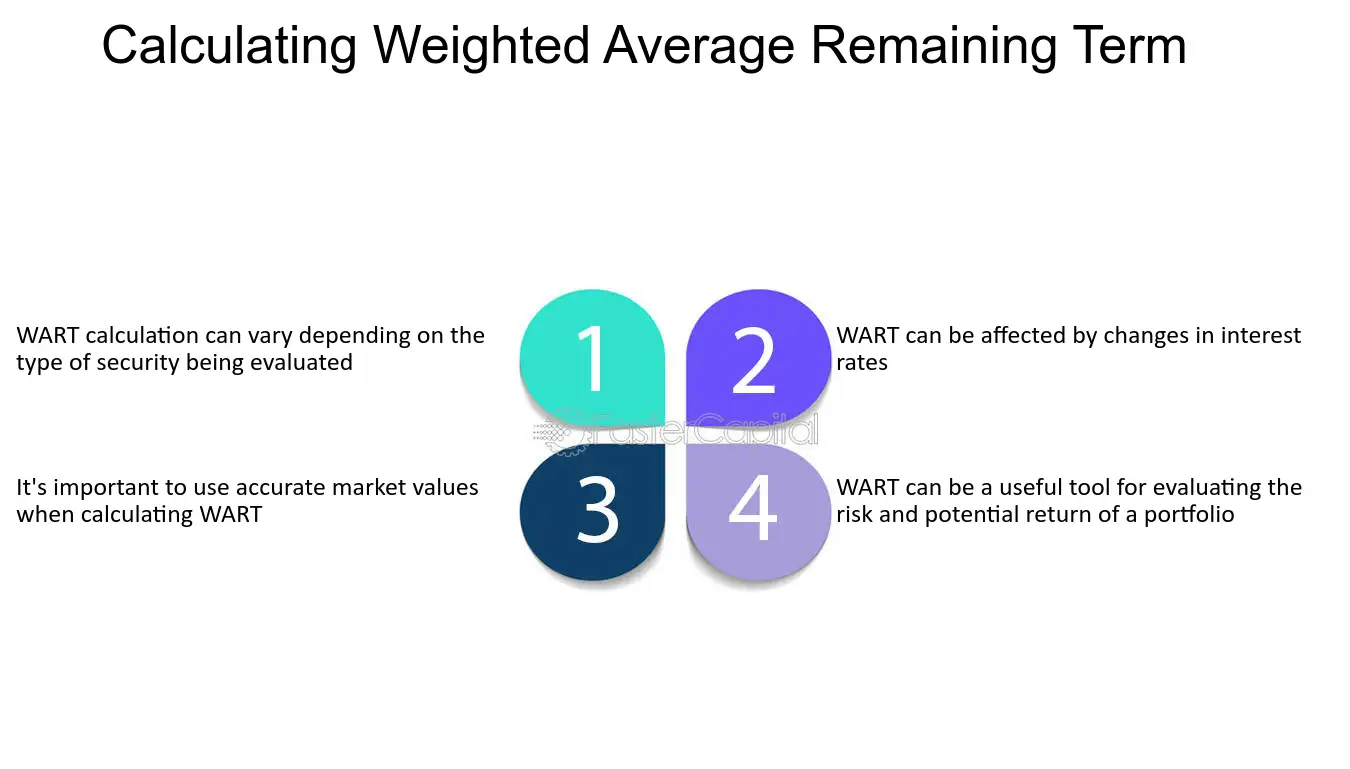Weighted Average Remaining Term (WART): Meaning, Example, and Importance

The Weighted Average Remaining Term (WART) is a financial metric used in fixed income trading strategy and education. It provides a measure of the average time remaining until the maturity of a portfolio of fixed income securities, weighted by their respective market values.
WART is calculated by multiplying the remaining term to maturity of each security by its market value, summing these values, and then dividing by the total market value of the portfolio. This calculation takes into account both the time remaining until maturity and the relative importance of each security in the portfolio.
For example, let’s consider a portfolio of fixed income securities with three holdings:
- Security A: Remaining term to maturity of 2 years, market value of $10 million
- Security B: Remaining term to maturity of 3 years, market value of $5 million
- Security C: Remaining term to maturity of 1 year, market value of $7 million
To calculate the WART of this portfolio, we would multiply the remaining term to maturity of each security by its market value:
- Security A: 2 years * $10 million = $20 million
- Security B: 3 years * $5 million = $15 million
- Security C: 1 year * $7 million = $7 million
We then sum these values: $20 million + $15 million + $7 million = $42 million.
Finally, we divide this sum by the total market value of the portfolio, which is $10 million + $5 million + $7 million = $22 million.
Therefore, the WART of this portfolio is $42 million / $22 million = 1.91 years.
The WART is an important metric for fixed income traders and investors as it provides insight into the average time until the maturity of the portfolio. It can be used to assess the interest rate risk and potential volatility of the portfolio, as securities with longer remaining terms to maturity are generally more sensitive to changes in interest rates.
By calculating and monitoring the WART, traders and investors can make informed decisions about the composition and management of their fixed income portfolios. It can help them determine whether to adjust the portfolio’s duration or take other actions to mitigate risk or take advantage of market opportunities.
The Weighted Average Remaining Term (WART) is a financial term used in fixed income trading and investment strategies. It is a measure that helps investors and traders assess the average time remaining until the maturity of a portfolio of fixed income securities.
What is WART?

WART is calculated by multiplying the remaining term to maturity of each security in the portfolio by its respective weight, summing up these values, and dividing the sum by the total weight of the portfolio. In other words, it is the weighted average of the remaining terms of all the securities in the portfolio.
For example, consider a portfolio consisting of three fixed income securities:
- Security A with a remaining term of 2 years and a weight of 40%
- Security B with a remaining term of 3 years and a weight of 30%
- Security C with a remaining term of 5 years and a weight of 30%
To calculate the WART of this portfolio, we would multiply the remaining term of each security by its weight:
(2 years * 40%) + (3 years * 30%) + (5 years * 30%) = 0.8 years + 0.9 years + 1.5 years = 3.2 years
Finally, we divide the sum by the total weight of the portfolio:
3.2 years / 100% = 3.2 years
The WART of this portfolio is 3.2 years, indicating the average time remaining until the maturity of the securities in the portfolio.
Importance of WART

WART is an important metric for fixed income investors and traders as it provides insight into the average maturity profile of a portfolio. It helps them understand the potential interest rate risk and cash flow characteristics of the portfolio.
A higher WART indicates a longer average time until maturity, which means the portfolio is more sensitive to changes in interest rates. On the other hand, a lower WART suggests a shorter average time until maturity, indicating less sensitivity to interest rate changes.
By analyzing the WART, investors can make informed decisions about their fixed income portfolios. They can adjust the portfolio’s duration and manage the interest rate risk based on their investment objectives and market expectations.

Emily Bibb simplifies finance through bestselling books and articles, bridging complex concepts for everyday understanding. Engaging audiences via social media, she shares insights for financial success. Active in seminars and philanthropy, Bibb aims to create a more financially informed society, driven by her passion for empowering others.
